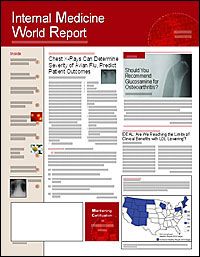Publication
Article
Internal Medicine World Report
Predictor of Lethal Complication in Sickle Cell Anemia Discovered
Author(s):
ATLANTA?At the recent meeting of the American Society of Hematology (ASH), investigators reported on a remarkable discovery: an important predictor of death in patients with sickle cell anemia that had not been recognized before in this context.
This biomarker, which was much ?dis?cussed in association with heart disease in the past few years, is brain natriuretic peptide (BNP), a protein that signals the presence of pulmonary hypertension, a common, often lethal, complication of sickle cell syndromes. Testing BNP levels in this patient population for the diagnosis of ?pulmonary hypertension is a significant breakthrough, according to some experts.
"Although the management of patients with sickle cell disease has improved ?dramatically in the past 40 years, many still have life-threatening problems," said James N. George, MD, of the University of Oklahoma Health Sciences Center, Oklahoma City, and president of ASH. "This pioneering discovery offers new insight for identifying patients at risk for critical complications."
Dr George, who introduced the re?search but was not involved in the study, explained that when the heart is under pressure from pulmonary hypertension, ventricles release BNP. Investigators at the National Heart, Lung, and Blood Institute (NHLBI) and colleagues participating in the Multicenter Study of Hydroxyurea Patients' Follow-Up hypo?thesized that the greater the pressure strain on the heart, the more BNP would be released, and therefore, the higher BNP levels would show who had pulmonary ?hypertension.
To test the hypothesis, BNP levels were measured in 230 patients with sickle cell disease and in 45 healthy controls. BNP levels were found to be higher in the sickle cell patients with pulmonary hypertension than in patients without it or in the controls. "An abnormally high BNP level [>160 pg/mL] was a clear predictor of mortality, increasing the risk of death 2-fold," the investigators said.
To confirm the finding independently, BNP levels were measured in banked blood samples of a separate group of 121 pa?tients with sickle cell disease enrolled in the Patients' Follow-Up study, which was launched in 1996. Again a high pro?spective risk of death was associated with a high BNP level; it was found in 30% of these patients.
"This measure independently predicted future death, even when controlled for other factors, such as the rate of pain episodes," reported lead investigator Roberto Machado, MD, of the NHLBI. "Considering that pulmonary hypertension is common and at the same time a lethal risk factor in patients with sickle cell disease, a test that could assess this major risk is potentially helpful."
ASH leaders honored the discovery by selecting the study to be the first presen?ted at the annual meeting's prestigious plenary session. They called it "the major groundbreaker from among thousands of studies submitted from around the world."
Dr Machado's colleague Mark Gladwin, MD, of the NHLBI's vascular medicine branch, noted that "The data indicate that the greatest risk factor for death in sickle cell disease is not the frequency of painful crises or the acute chest syndrome?as clinicians commonly believe?but rather unrecognized pulmonary hypertension."
Other Anemia-Related News
At a special symposium called "Anemia and the Elderly: A Public Health Crisis," experts pointed out that alth?ough anemia is escalating in the elderly, it is frequently unrecognized and untreated. Yet, even mild anemia is often associated with clinical impairment. William Ershler, MD, of the National Institute on Aging, added that anemia may occur in >20% of elderly Americans. It has been reported to be an independent predictor of mortality. He contrasted the normal physiology of erythropoietin with pathologic changes seen in the aged and urged physicians with older patients to heed this problem.
A new Australian-led international study of the anemia drug darbepoetin-alfa (Aranesp) confirmed that when it was ad?ministered every 3 weeks to patients with cancer who had chemotherapy-induced anemia, the drug maintained hemoglobin at a healthy level of >=11g/dL and reduced the need for red blood cell transfusions by almost 50% compared with placebo. In?vestigator Kerry Taylor, MD, Mater Hospital, South Brisbane, Queensland, re?ported results for 386 patients, which showed that 77% of those receiving darbepoetin-alfa achieved target hemoglobin levels compared with 55% taking placebo. "If approved," he said, "this extended dosing could allow physicians to treat ane?mia on the same 3-week schedule as chemo?therapy, greatly reducing clinic visits."
Patients with profound anemia who refuse blood transfusions may survive with simple nonblood strategies, according to investigators from the Center for Bloodless Medicine and Surgery, Penn?sylvania Hospital, Philadelphia. They stressed simultaneous interventions to stimulate erythropoiesis, control bleeding, enhance hemostasis, minimize iatrogenic blood loss, and maintain hemodynamic stability. Some patients started with hemoglobin levels at 2.5 g/dL. Although most patients experienced slower-than-normal recovery times, with more frequent cardiac monitoring and increased length of hospital stays, physicians' clinical skills managed the difficulties. Thus, of 128 patients, 122 (95.3%) survived, despite advanced age and underlying cardiovascular conditions in some of the patients.





